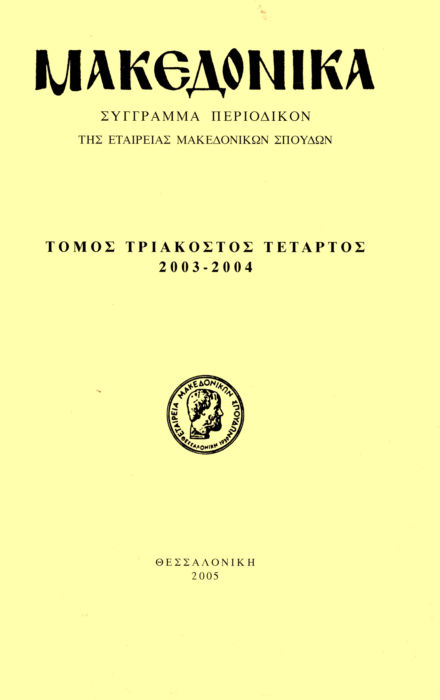Martyrdom of the Forty Martyrs of Sebasteia: revival of an «archaic» iconographie type in post-byzantine icons of the athonite monastery of Xeropotamou
Abstract
The legend of the martyrdom of the Forty Martyrs of Sebasteia, as well as its’ consecutive stages, have survived through the centuries thanks to the Homilies of Basil the Great and his brother Grerory of Nyssae. From those stages, Byzantine artists usually depict the peak of their martyrdom, the stay of the martyrs for a whole night on a frozen lake in Sebasteia. The icono graphy of this particular event has been developped in the 10th century and has consequently been reproduced as a stereotype, until post-byzantine period. On the other hand, in some illustrated manuscripts and mural paintings of 11th and 12th centuries, artists proceed to the development of iconographie cycles, which include from four to eight episodes of the saints’ martyrdom. The cycles, however, are differentiated one from another, in the matter of selection and representation of the episodes. These variations point out the lack of one steady, repeatidly in use iconographie type.
The legend of the martyrdom of the Forty Martyrs revives some centuries later, in three unpublished icons of the second half of the 18th century, from the athonite Monastery of Xeropotamou. In all three of them, one notices the development of the same short iconographie cycle, with three episodes that follow the main event, the stay of the martyrs on the lake. The cycle contains the chopping of the martyrs by their executioners, the transportation of their bodies by carriage and finally their burning into an immense fire. The same scenes also meet at an engraved copperplate of the year 1764, ordered at Venice by the Monastery of Xeropotamou. It seems that this iconographie cycle was inspired not by the 4th century Homilies of Basil the Great and Gregory of Nyssae, but by versions of the post-byzantine period, which are to be found at the library of the Xeropotamou Monastery. Obviously, the iconography of the saints’ martyrdom was reformulated at Xeropotamou Monastery, which is dedicated to the memory of the Forty Martyrs of Sebasteia. From the beginning of the 19th century, the same iconographie type is to be seen in many other portable icons depicting the Forty Martyrs, like the one at the treasury of the athonite Vatopediou Monastery.
Article Details
- How to Cite
-
Παζαράς Ν. Θ. (2004). Martyrdom of the Forty Martyrs of Sebasteia: revival of an «archaic» iconographie type in post-byzantine icons of the athonite monastery of Xeropotamou. Makedonika, 34(1), 251–271. https://doi.org/10.12681/makedonika.875
- Issue
- Vol. 34
- Section
- Articles

This work is licensed under a Creative Commons Attribution-NonCommercial-ShareAlike 4.0 International License.
Authors who publish with this journal agree to the following terms:
- Authors retain copyright and grant the journal right of first publication with the work simultaneously licensed under a Creative Commons Attribution Non-Commercial License that allows others to share the work with an acknowledgement of the work's authorship and initial publication in this journal.
- Authors are able to enter into separate, additional contractual arrangements for the non-exclusive distribution of the journal's published version of the work (e.g. post it to an institutional repository or publish it in a book), with an acknowledgement of its initial publication in this journal.
- Authors are permitted and encouraged to post their work online (preferably in institutional repositories or on their website) prior to and during the submission process, as it can lead to productive exchanges, as well as earlier and greater citation of published work (See The Effect of Open Access).



